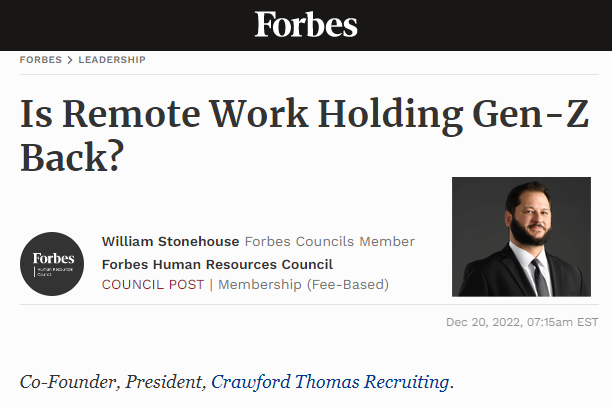Co-Founder, President, Crawford Thomas Recruiting.
Original article here.

Could working from home be holding an entire generation back? Gen-Z currently makes up about 12.6% of the workforce, and both executives and members of the group feel remote work comes with a unique set of challenges for entry-level employees.
Unlike other generations, Gen-Z entered the workforce at an unprecedented time—most current entry-level talent has only ever worked remotely or in hybrid settings. Learning nuances of the workplace is difficult enough in person. On-the-job training isn’t happening the way it used to through inadvertent observation. Instead, Gen-Zers are having to decipher instructions and requests through instant messages, email and video calls. With some nuances lost through technological communication, it can be anxiety-inducing, leaving plenty of room for misunderstandings or conflict.
Feedback can be seen as daunting or dreaded as Gen-Z is forced to analyze edits marked in red text with brief explanations or short and blunt instant message responses. They may not have the opportunity to connect with their co-workers in person for more clarity as we once did. Work may feel more transactional in a virtual world, with the risk of people feeling less passionate about their job due to a lack of connection.
In a virtual environment, entry-level employees may not feel as tight-knit in the workplace community. Instead of bumping into senior-level executives or having the opportunity to get to know their colleagues at the coffee station, associates may seem unapproachable or intimidating to reach out to over virtual messaging platforms. Unless remote employees develop these crucial networking tools on their own time, these moments of professional growth through “osmosis” and connecting with colleagues could be reduced or nonexistent.
Organic mentorship programs may feel forced or deprioritized due to the meetings being scheduled blocks of time versus face-to-face, casual lunch meetings. Finally, with these meetings occurring in the virtual world, younger generations may find it harder to build trust and develop genuine work relationships.
Remote work is here to stay, so companies will need to spearhead closing the gaps to cultivate the next generation of the workforce. Here are some tips based on my experience:
• Consider a hybrid model or regular in-office days. Get the team together weekly, bi-weekly or monthly—whatever works best for your company. This option appeases both employees who prefer to work remotely and those who operate best in an in-person work environment.
• Promote organic connection. People should not be forced into an office just because—many employees are equally as productive while working from home. If your company chooses to remain fully remote, make sure to incorporate moments that help replicate the “water cooler chat” that happens in a traditional in-office setting. Initiatives like “speed networking” or other interactive challenges can help employees foster relationships and regain a sense of community. Encourage a “cameras on” policy, but also be aware of virtual fatigue. Leave enough time for employees to catch up on a personal, human level.
• Modify your existing company culture work to fit in a virtual world. Focus on building and maintaining a positive company culture. Ensure any in-person events are high quality and align with what your employees want to attend and participate in. Foster a culture of constructive, open feedback.
• Prioritize mentorship by pairing the most experienced employees with junior-level staff. A big focus should be put on transferring the skills of those who will soon be transitioning out of the workforce to Gen-Z and beyond.
Most importantly, meet Gen-Z where they are. They entered an unusual workforce, so their progression could also be unusual by corporate standards.

Co-Founder, President, Crawford Thomas Recruiting. Read William Stonehouse’s full executive profile here.
About Crawford Thomas Recruiting:
Crawford Thomas is a team of leading HR recruiters. We not only fill staffing needs, we partner with organizations to find out how their recruiting needs tie into their business objectives. Through this, we are able to meet your staffing needs in a way that achieves organizational success.
Start securing top talent by visiting our page for employers today.

